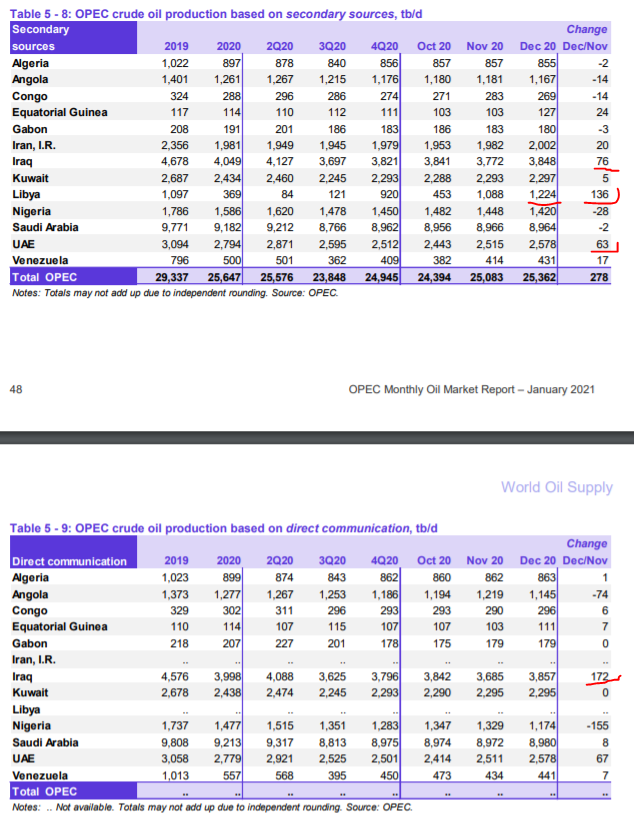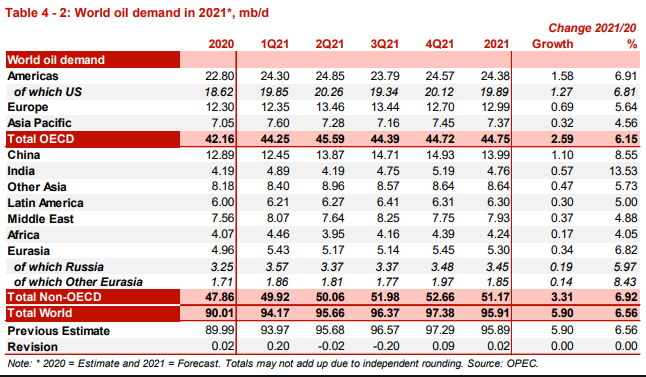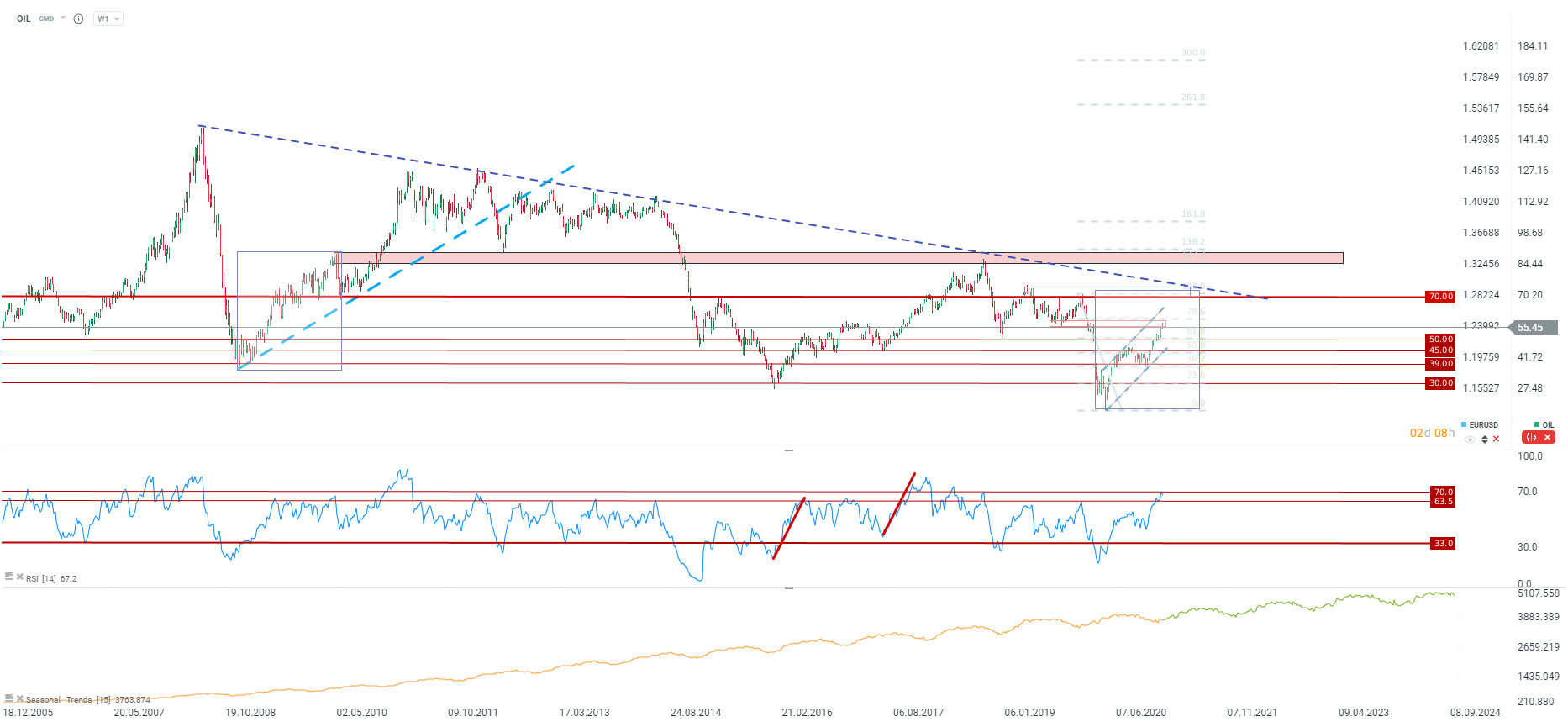Summary:
- OPEC does not significantly change its demand forecasts
- December production up by almost 0.3 mbd,
- Production in Libya at 1.3 mbd - will there be pressure to impose a production cap on this country?
- Supply outside OPEC this year is expected to increase by 0.8 mbd (increase in supply on the US side, decrease on the side of Russia)
What does the OPEC report say?
Start investing today or test a free demo
Create account Try a demo Download mobile app Download mobile appCurrently, OPEC production averaged around 25.36 mbd in December. Therefore, the increase in production amounted to almost 0.3 mbd compared to November. Meanwhile, OPEC + was expected to increase production by 0.5mbd in January, while in February production will be left unchanged, with an additional voluntary Saudi Arabia cut of 1mbd (also in March). On the one hand, this is an effect of uncertainty regarding demand. On the other hand, it is a response to the actions of other producers. Currently, it can be seen that not only Libya has increased production (last year production was close to zero, and now 1.3 mbd), but also the UAE and Iraq. OPEC must also watch out for a possible return of production from the United States, which at current prices may quickly restore production at the level of 1-2 mbd.
 It is worth noting the huge increase in production from Libya in recent months. Source: OPEC
It is worth noting the huge increase in production from Libya in recent months. Source: OPEC
 OPEC expects an increase in demand this year at 5.9 mbd, compared to last year. The first quarter of this year is to look better. Despite this, Saudi Arabia decided to take a non-standard step. Can we therefore expect the price will hit "slightly absurd" levels, waiting for a strong return of supply from other sides, which will bring down the market in the second half of this year? Source: OPEC
OPEC expects an increase in demand this year at 5.9 mbd, compared to last year. The first quarter of this year is to look better. Despite this, Saudi Arabia decided to take a non-standard step. Can we therefore expect the price will hit "slightly absurd" levels, waiting for a strong return of supply from other sides, which will bring down the market in the second half of this year? Source: OPEC
 To keep the market balanced, OPEC needs to produce roughly 27 million barrels per day this year. This does not offer great prospects for the cartel to increase production. Moreover, OPEC wants to further reduce OECD inventories, which means that theoretically production should remain around 25-26 mbd this year. This means that the second half of the year may be a challenge for buyers, given that many OPEC countries are tired of the existing production limits. Source: OPEC
To keep the market balanced, OPEC needs to produce roughly 27 million barrels per day this year. This does not offer great prospects for the cartel to increase production. Moreover, OPEC wants to further reduce OECD inventories, which means that theoretically production should remain around 25-26 mbd this year. This means that the second half of the year may be a challenge for buyers, given that many OPEC countries are tired of the existing production limits. Source: OPEC
 Brent pulled back slightly this week after reaching an important supply zone, the upper limit of which is located around $ 60 a barrel. From a technical perspective, it can be seen that the market is not yet extremely overbought (even the RSI is not at extreme levels, although above 70 pts). The short-term target is located around $ 60 per barrel. Many institutions indicate that the price of crude oil may even reach USD 65 per barrel. Looking at the behavior of crude oil after the previous crisis, the first upward wave finished around $ 90 per barrel. The current "post-crisis" wave started lower than the last one, which means that the price could reach $70-74 per barrel. This level also coincides with the long-term uptrend line. Source: xStation5
Brent pulled back slightly this week after reaching an important supply zone, the upper limit of which is located around $ 60 a barrel. From a technical perspective, it can be seen that the market is not yet extremely overbought (even the RSI is not at extreme levels, although above 70 pts). The short-term target is located around $ 60 per barrel. Many institutions indicate that the price of crude oil may even reach USD 65 per barrel. Looking at the behavior of crude oil after the previous crisis, the first upward wave finished around $ 90 per barrel. The current "post-crisis" wave started lower than the last one, which means that the price could reach $70-74 per barrel. This level also coincides with the long-term uptrend line. Source: xStation5
This content has been created by XTB S.A. This service is provided by XTB S.A., with its registered office in Warsaw, at Prosta 67, 00-838 Warsaw, Poland, entered in the register of entrepreneurs of the National Court Register (Krajowy Rejestr Sądowy) conducted by District Court for the Capital City of Warsaw, XII Commercial Division of the National Court Register under KRS number 0000217580, REGON number 015803782 and Tax Identification Number (NIP) 527-24-43-955, with the fully paid up share capital in the amount of PLN 5.869.181,75. XTB S.A. conducts brokerage activities on the basis of the license granted by Polish Securities and Exchange Commission on 8th November 2005 No. DDM-M-4021-57-1/2005 and is supervised by Polish Supervision Authority.

